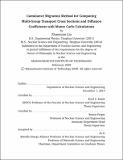| dc.contributor.advisor | Kord S. Smith and Benoit Forget. | en_US |
| dc.contributor.author | Liu, Zhaoyuan,Ph. D.Massachusetts Institute of Technology. | en_US |
| dc.contributor.other | Massachusetts Institute of Technology. Department of Nuclear Science and Engineering. | en_US |
| dc.date.accessioned | 2021-02-19T20:59:39Z | |
| dc.date.available | 2021-02-19T20:59:39Z | |
| dc.date.copyright | 2020 | en_US |
| dc.date.issued | 2020 | en_US |
| dc.identifier.uri | https://hdl.handle.net/1721.1/129924 | |
| dc.description | Thesis: Ph. D., Massachusetts Institute of Technology, Department of Nuclear Science and Engineering, February, 2020 | en_US |
| dc.description | Cataloged from student-submitted PDF version of thesis. | en_US |
| dc.description | Includes bibliographical references (pages 209-214). | en_US |
| dc.description.abstract | In nuclear reactor physics analysis, fast accurate deterministic methods are needed for the many full-core calculations required for safe and efficient operation of nuclear power plants. Multi-group diffusion coefficients and transport cross sections are the crucial parameters that balance efficiency and accuracy in full-core simulations. However, it is not clear what definition of diffusion coefficients and transport cross sections should be employed or what "transport properties" are preserved by the numerous approximations available in the literature. Among the sources of error associated with efficient deterministic simulations of nuclear reactors, whether diffusion or transport theory, the anisotropy of neutron scattering introduces one major challenge for achieving highly accurate eigenvalues and power distributions. Anisotropic scattering has a significant impact on the neutron spatial migration, which is an important transport property in nuclear reactor systems. | en_US |
| dc.description.abstract | It is well known that the scattering is highly forward-peaking when neutrons collide with light nuclides such as hydrogen in water, but how anisotropic scattering contributes to neutron migration has not been thoroughly studied. The Cumulative Migration Method (CMM) is developed in this thesis as a new method for computing multi-group diffusion coefficients and transport cross sections using Monte Carlo methods which preserves migration area. Thus, CMM is able to overcome the shortcomings of commonly-applied transport approximations. CMM is directly applicable to lattice calculations performed by Monte Carlo and is capable of producing rigorous homogenized diffusion coefficients and transport cross sections for arbitrarily heterogeneous lattices. By preserving neutron migration area, CMM also improves the accuracy of heterogeneous transport cross sections in multi-group transport calculations. | en_US |
| dc.description.abstract | The advantage of CMM in achieving higher accuracy in full-core calculations is demonstrated on a series of 2D benchmark problems with both water and graphite moderators. The transport correction using CMM significantly improved agreement in full-core simulation results compared with other approximations. Consistent improvement is shown in reducing the error of eigenvalue and migration area. By employing pre-computed continuous energy correction tables for light nuclides, CMM offers a potential pathway to improve tally capabilities of existing Monte Carlo codes in generating transport cross sections. | en_US |
| dc.description.statementofresponsibility | by Zhaoyuan Liu. | en_US |
| dc.format.extent | 214 pages | en_US |
| dc.language.iso | eng | en_US |
| dc.publisher | Massachusetts Institute of Technology | en_US |
| dc.rights | MIT theses may be protected by copyright. Please reuse MIT thesis content according to the MIT Libraries Permissions Policy, which is available through the URL provided. | en_US |
| dc.rights.uri | http://dspace.mit.edu/handle/1721.1/7582 | en_US |
| dc.subject | Nuclear Science and Engineering. | en_US |
| dc.title | Cumulative migration method for computing multi-group transport cross sections and diffusion coefficients with Monte Carlo calculations | en_US |
| dc.type | Thesis | en_US |
| dc.description.degree | Ph. D. | en_US |
| dc.contributor.department | Massachusetts Institute of Technology. Department of Nuclear Science and Engineering | en_US |
| dc.identifier.oclc | 1237642269 | en_US |
| dc.description.collection | Ph.D. Massachusetts Institute of Technology, Department of Nuclear Science and Engineering | en_US |
| dspace.imported | 2021-02-19T20:59:09Z | en_US |
| mit.thesis.degree | Doctoral | en_US |
| mit.thesis.department | NucEng | en_US |
